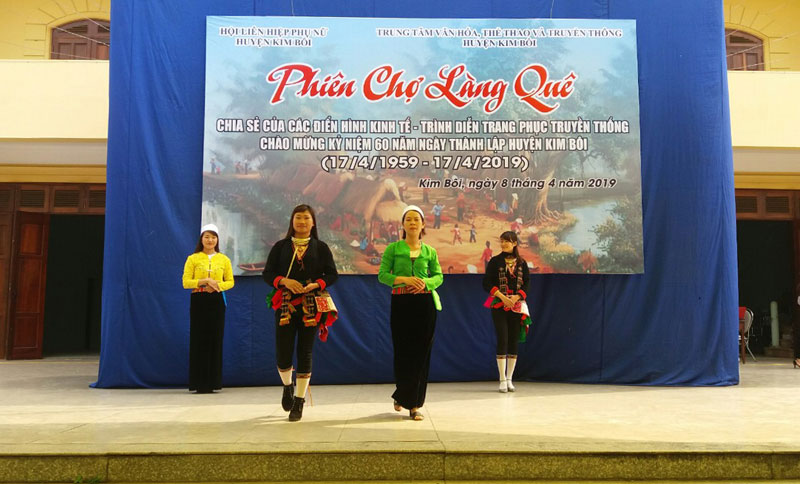
(HBO) – The Vietnam Women’s Union’s chapter in Kim Boi district in collaboration with the centre for culture-sport and tourism on April 8 organised a rural trade fair to honour standout economic models. A show featuring traditional costumes was also held as part of the event.
Featuring
30 booths of 28 communes and towns and several organisations in the districts,
the fair introduced a wide range of local staples like traditional dishes,
vegetables and fruits as well as traditional medicines.
The event was organised to popularise local agricultural products, contributing
to developing a complete value chain for the farmers. Also, it helped raise
public awareness of the importance of safe food to consumers’ health.
Participants join performance of
traditional costumes at the rural fair.
Particularly, a performance of traditional costumes was organised in the
framework of the fair, drawing the participation of 155 people from 31
organisations in the district. It aimed
to preserve traditional cultural values in general and local costumes in
particular. This was also part of the activities to celebrate the 60thfounding anniversary of Kim Boi district (April 17, 1959-2019).
With an increasingly vibrant and widespread emulation movement aimed at building cultured residential areas and cultured families, Yen Thuy District has been making steady progress toward improving both the material and spiritual well-being of its people, while fostering a civilized, prosperous, beautiful, and progressive community.
Once lacking recreational spaces and community facilities, Residential Group 2 in Quynh Lam Ward (Hoa Binh City) has recently received attention for the construction of a new, spacious, and fully equipped cultural house. The project followed the model of state support combined with public contributions in both labor and funding.
The "All people unite to build cultural life" movement, which has been effectively integrated with Kim Boi district’s socio-economic development goals, is fostering a lively spirit of emulation across local residential areas, hamlets, villages, public agencies, and enterprises. In addition, through the initiative, traditional cultural values are being preserved and promoted, while community solidarity and mutual support in poverty reduction and economic development are being strengthened.
A working delegation of the Hoa Binh provincial People’s Committee led by its Permanent Vice Chairman Nguyen Van Toan on June 11 inspected the progress of a project to build the Mo Muong Cultural Heritage Conservation Space linked to tourism services in Hop Phong commune, Cao Phong district.
Born and growing in the heroic land of Muong Dong, Dinh Thi Kieu Dung, a resident in Bo town of Kim Boi district, in her childhood was nurtured by the sweet lullabies of her grandmother and mother. These melodies deeply imprinted on her soul, becoming an inseparable part of her love for her ethnic group's culture. For over 20 years, this love for her hometown has driven Dung to research, collect, and pass down the cultural values of the Muong people to future generations.
In the final days of May, the Ethnic Art Troupe of Hoa Binh Province organized performances to serve the people in remote, mountainous, and particularly disadvantaged areas within the province. These were not just ordinary artistic shows, but they were the meaningful journeys aimed at spreading cultural values, enhancing the spiritual life of the people and contributing to the preservation of ethnic minority cultural identities.



